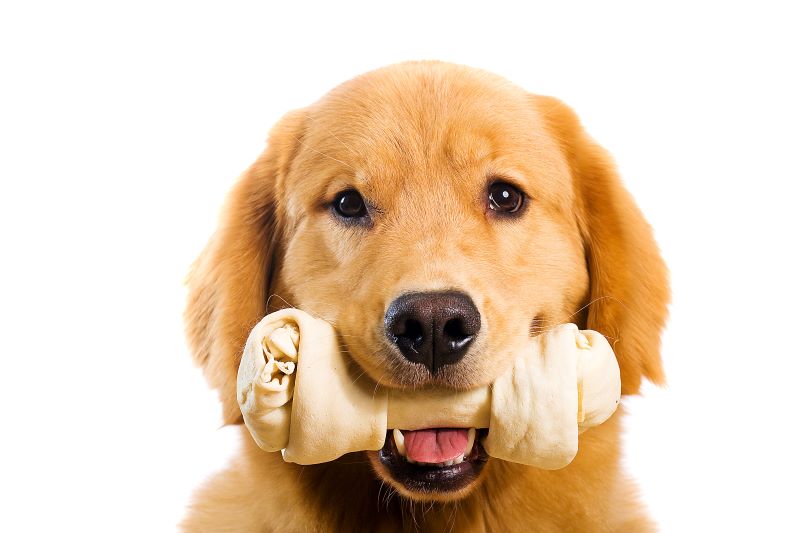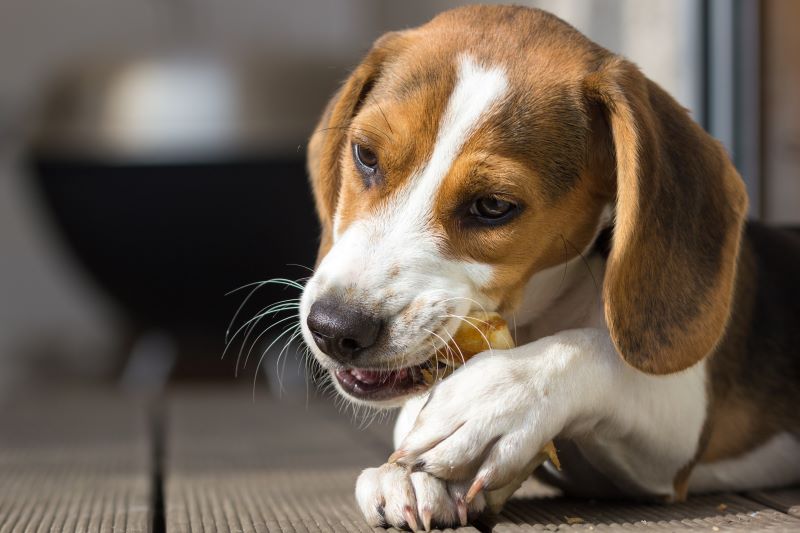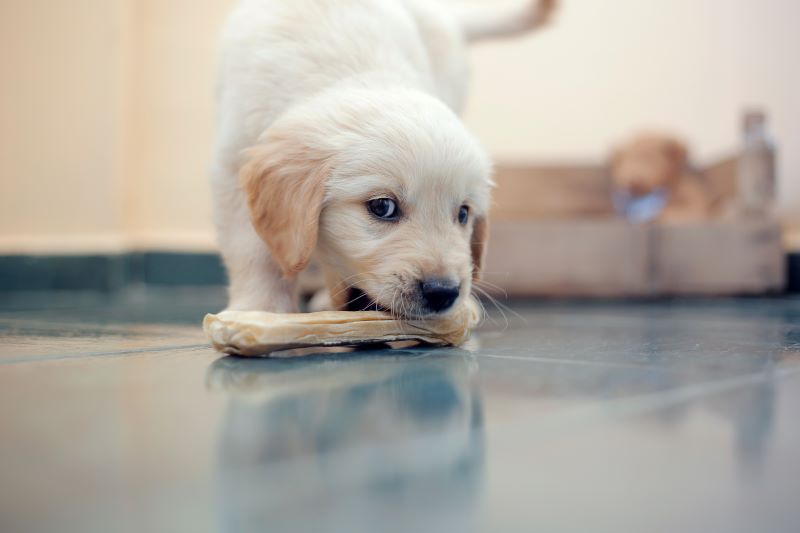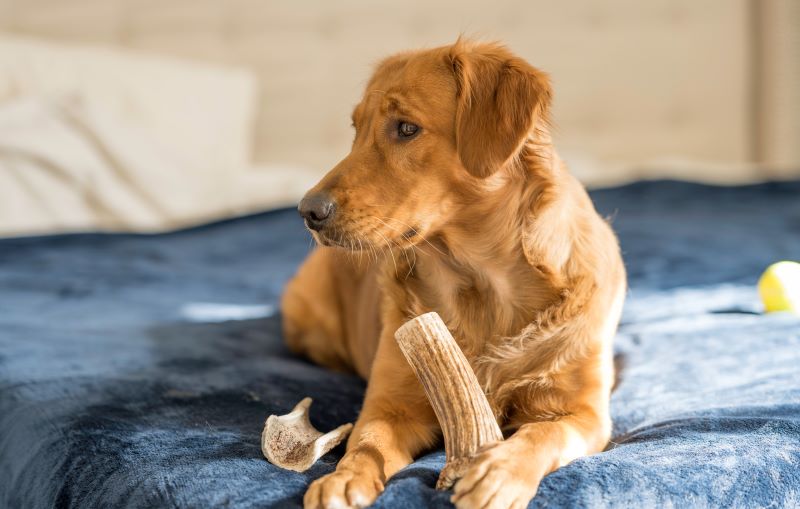
Dogs have an inherent love for chewing, and rawhide bones have been a popular choice for pet owners seeking to satisfy this instinct. However, ask any veterinarian, and they will tell you about the safety and potential risks associated with rawhide consumption. So let’s dive right in and answer some of the questions we often get about rawhide.
Key questions this blog answers:
- What is rawhide?
- Why is rawhide potentially bad for dogs?
- Is rawhide safe for dogs in moderation?
- What are some rawhide alternatives?
What is Rawhide?
Rawhide, that ever-popular chewable treat dogs just can’t seem to get enough of, actually starts its journey as the inner layer of animal hides, coming mainly from cows or pigs. The majority of rawhide production is based in China.
The journey from animal hide to rawhide chew begins with the collection of animal skins, which are then soaked in salt to prevent them from spoiling. But here’s the kicker: sometimes, these skins have to chill out in storage for a few months until they’re ready for the next step. And even with the salt, some of these skins might begin to decay slightly during this waiting game.
Next, the skins are taken to a tannery. Here, the workers use lime to remove any fat from the skin. After that, they use a combination of chemicals and physical scrubbing to get rid of the hair. To finish up, they wash the rawhide one more time.
In some cases, rawhide is soaked in bleach or hydrogen peroxide. These are powerful cleaning agents that should never be ingested.
Is Beefhide the Same as Rawhide?
The terms “rawhide” and “beefhide” are often used interchangeably, but there is a slight difference. Beefhide specifically refers to rawhide made from cattle hides, while rawhide may encompass hides from other animals like pigs and even horses. Despite this difference, both are processed similarly and raise similar concerns regarding safety.
Why is Rawhide Bad for Dogs?
While rawhide can offer benefits like scraping away plaque and tartar as well as mental stimulation, it also poses potential risks. One of the primary concerns is the risk of choking or intestinal blockages. When dogs chew on rawhide, small pieces can break off and become lodged in their throat or digestive tract, leading to serious health complications. Additionally, some rawhide products may contain harmful chemicals or preservatives used during processing.
Can Dogs Digest Rawhide?
Dogs lack the necessary enzymes to digest rawhide fully. While some pieces may pass through the digestive system without issue, others can cause obstructions or irritation along the way. This incomplete digestion contributes to the risk of gastrointestinal problems.

Key Health Concerns Associated with Rawhide for Dogs
- Choking Hazard: If you have experience with rawhides then you know about the pieces that end up all over your rugs, carpet, lodged in their beds, etc. Rawhide breaks off into pieces while dogs chew, and this causes choking risks when swallowed, as pieces can become lodged in the throat.
- Intestinal Blockages: When ingested, rawhide can form clumps or blockages in the digestive tract. This can lead to severe abdominal pain, vomiting, diarrhea, and potentially the need for surgical intervention.
- Digestive Irritation: Dogs lack the enzymes necessary to fully digest rawhide, which can lead to digestive upset, including diarrhea, vomiting, and gastrointestinal discomfort.
- Chemical Contaminants: Some rawhide products may contain harmful chemicals or preservatives used during processing, posing health risks to dogs if ingested over time. These contaminants can lead to gastrointestinal irritation, toxicity, allergic reactions, increased cancer risk, endocrine disruption, and neurological effects.
- Bacterial Contamination: Yuck! We pet parents don’t enjoy the messy, half-chewed rawhide our dogs love to drag around. Turns out, we are right to pause as improper storage and/or processing of rawhide can lead to bacterial contamination, including Salmonella and E. coli, which may cause illness in dogs and humans who come into contact with the product.
- Allergic Reactions: Dogs may develop allergic reactions to components of rawhide, such as dyes, flavorings, or even the hide itself, resulting in symptoms like itching, swelling, or yes, you guessed it: gastrointestinal distress.
- Dental Damage: While rawhide can help promote dental health by scraping away plaque and tartar, aggressive chewing on hard materials like rawhide can also lead to dental fractures, chips, or wear over time, especially in pups with smaller teeth.
- Behavioral Issues: In some cases, dogs may become possessive or aggressive over their rawhide chew, leading to conflicts with other pets or even with their owners. Of course, this can happen with any type of chew or toy they become overly attached to.
Are All Rawhide Bones Bad for Dogs?
Not all rawhide products are created equal. High-quality, natural rawhide sourced from reputable manufacturers may pose fewer risks compared to cheaper alternatives laden with chemicals and additives. However, even with better-quality rawhide, there’s still a risk of choking or blockages, so pet owners should always remain observant during chewing sessions.

How to Choose Rawhide Bones
Choosing high-quality, natural rawhide chews for your dog is crucial for ensuring their safety and health. Here are some tips to help you identify high-quality rawhide sourced from reputable manufacturers:
- Country of Origin: Look for rawhide made in countries with strict manufacturing and quality control standards. Products made in the USA, Canada, and some European countries are often subject to more rigorous health and safety regulations.
- Manufacturing Process: Seek out information on the manufacturing process. High-quality rawhide is typically cleaned with safe, non-toxic agents and does not contain harmful chemicals. Avoid rawhide treated with bleach or other harsh chemicals to whiten the product.
- Single Source Protein: High-quality rawhide often comes from a single source of protein, such as beef. This can be better for dogs with sensitive stomachs or allergies. Check the packaging for information on the source.
- Brand Reputation: Research the brand to ensure they have a good reputation for safety and quality. Look for brands that are transparent about their sourcing and manufacturing processes.
- Transparency and Certifications: Look for products that have clear labels regarding their contents and origin. Certifications from reputable organizations (like the USDA in the United States) can also be a sign of high-quality standards.
- Ingredient List: The best rawhide chews usually have a short and simple ingredient list. High-quality rawhide is typically all-natural and does not contain artificial preservatives, colors, or flavorings.
- Consult Your Veterinarian: Your vet can provide personalized advice based on your dog’s health, size, and dietary needs. They may also recommend reputable brands or products.
- Avoid Bargain Products: While not always the case, very cheap rawhide chews can sometimes indicate lower quality or cut corners in the manufacturing process. Investing in higher-quality chews can be safer for your dog in the long run.
Is Rawhide Safe for Dogs in Moderation?
Once you find an all-natural rawhide that doesn’t contain artificial preservatives, colors, or flavoring, the key to safely offering rawhide lies in moderation and supervision. Limiting the frequency and duration of rawhide chewing sessions can help mitigate risks while still providing dogs with the benefits of dental care and mental stimulation. Supervision is essential to intervene if any issues arise.
How often can I give my dog rawhide?
It depends on the size of your dog and the size of the rawhide. If you choose to give your dog rawhide, do so in moderation and under close supervision. It’s best to limit rawhide consumption and explore safer, digestible alternatives.
What signs should I look for if my dog is having trouble with rawhide?
Be alert for signs of choking, gagging, drooling more than usual, or attempting to vomit. Remove the rawhide immediately and consult your vet if you notice any of these signs.
Rawhide Alternatives

Natural Chews:
- Bully Sticks: Made from dried beef pizzle, bully sticks are highly digestible and provide a satisfying chewing experience.
- Lamb Ears: Low in fat and easy to digest, lamb ears are a flavorful alternative to rawhide that many dogs enjoy.
Edible Dental Chews:
- Dental Bones: Designed to promote oral health, dental bones are typically made from natural ingredients like rice flour, chicken, and parsley.
- Dental Sticks: These textured sticks help clean teeth and freshen breath while being easily digestible for dogs.
Rubber or Nylon Toys:
- Kong Toys: Kong toys are durable rubber toys that can be stuffed with treats or peanut butter, providing mental stimulation and satisfying a dog’s need to chew.
- Rubber Chew Toys: There are many rubber chew toys on the market designed to withstand heavy chewing and promote dental health.
Vegetable-Based Chews:
- Carrots: Raw carrots are low in calories and high in fiber, making them a healthy and crunchy chew option for dogs.
- Sweet Potato Chews: Sliced and dehydrated sweet potatoes make a tasty and nutritious alternative to rawhide.
- Frozen Fruit or Veggie Cubes: Freeze small pieces of fruits or vegetables like apples, carrots, or green beans in water or broth for a refreshing and chewable treat.
Homemade Treats:
- Frozen Broth Cubes: Freeze low-sodium chicken or beef broth in ice cube trays for a cool and refreshing treat on hot days.
- Homemade Biscuits: Bake homemade dog biscuits using dog-safe ingredients like whole wheat flour, peanut butter, and pumpkin puree for a tasty and chewable snack.
Fish-Based Treats:
- Fish Skins: Dehydrated fish skins are a crunchy and protein-rich chew option that many dogs love.
- Salmon Jerky: Made from dried salmon, salmon jerky provides omega-3 fatty acids and a satisfying chew for dogs.
These alternatives offer a variety of textures, flavors, and benefits to keep dogs entertained, promote dental health, and satisfy their natural chewing instincts without the potential risks associated with rawhide. Always supervise your dog when introducing new chews or treats, and choose options appropriate for your dog’s size, age, and chewing habits.
A Warning About Nylabones: While Nylabones are designed to be a safer alternative to rawhide, they are not completely 100% safe for dogs.They are often made of a hard plastic that can damage teeth and leave very sharp edges.
Chewing Wisely: Final Thoughts on Rawhide for Dogs
While some dogs may enjoy rawhide without issue, the risks of choking, potential cancer-causing toxins, intestinal blockages, and gastrointestinal upset warrant careful consideration. By offering rawhide in moderation, opting for higher-quality products, and exploring alternative chew options, you can have more peace of mind while still indulging your pup’s natural chewing instincts.
Remember to ask your vet if he or she has any concerns about a particular rawhide or other treat you are considering for your pet. Your vet can provide personalized advice based on your pet’s health and dietary requirements.
The Harmony Promise: Our clients are our neighbors, friends, and family, so expect us to treat your pets as we treat our own.
Harmony Animal Hospital, Pet Resort & Spa: Your other family doctor.
Call (919) 303-3456 for an appointment or visit us at HarmonyAnimalHospital.net.

